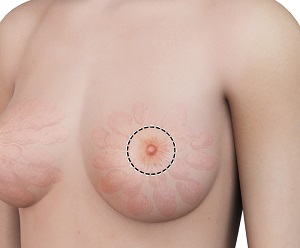
What are Breast Nipple Changes?
Unusual changes in your nipple shape, colour or secretions are known as breast nipple changes. There are numerous reasons associated with nipple changes. It is necessary to understand and diagnose nipple changes associated with cancer or infection or any other disorder.
Normal Nipple Changes
- Fluid discharge is common when you are breastfeeding or after two years of lactation. It sometimes occurs in premenopausal women. An infection may also cause temporary discharge. Unusual pressure also causes discharge.
- Hair growth around the nipple area in some women is common.
- Some women have an inverted nipple naturally and should not worry about it.
- The areolar tissue surrounding your nipples contains lubricating glands which may cause bumps in the tissue. This is a normal change.
- Some women experience changes in the colour of the areolar tissue during breastfeeding. This is completely normal, as your nipple returns to its normal colour after a few weeks.
- Cracking or nipple soreness may occur due to injury.
- Hormonal changes before menstruation may cause discomfort but it is temporary and normal.
- Increase in the size of the breasts and nipples during lactation is normal.
- Veins along your breast can appear darkened during pregnancy.
- Discharge from the breast which is not blood-coloured is normal.
- Tenderness and hypersensitivity of the breast during pregnancy is normal.
- Rigorous physical activity may cause nipple discharge.
Abnormal Nipple Changes
- Nipple discharge which is spontaneous must not be neglected.
- Straw-coloured or blood-coloured discharge is abnormal.
- Ulceration and swelling of the nipple are abnormal.
- Discharge from the nipple of only one breast is abnormal.
The above symptoms may be due to benign or malignant tumours but can be confirmed only by a medical test.
Paget’s Disease of the Nipple
This is a type of breast cancer of the nipple characterised by a red, scaly and itchy nipple and areola. In this condition, milk ducts may become cancerous and carry cancerous cells to the nipple surface or the cells of the nipple itself may turn cancerous. This is a rare form of breast cancer compared to other types of breast cancer.
Breast Cancer and Nipple Changes in Men
Breast cancer occurs in men too, but the number is low compared to women. Do not neglect the following symptoms and call your doctor if these symptoms exist:
- Puckering or dimpling of skin around the breast
- Scaling and redness of the nipple
- Inward retraction of the nipple
- Discharge from the nipple
Nipple Discharge
The colour of the nipple discharge may or may not always give an indication of what disorder you are suffering from, but basic knowledge of the discharge is necessary for early detection and treatment.
Milky White discharge: Usually, milky discharge occurs from both breasts. Other than lactation, a milky discharge may be due to certain medications or hormonal imbalance. One of the reasons may be a tumour in the pituitary gland (a gland which controls the regulation of all the hormones in your body).
Sticky and Multicoloured discharge: This usually occurs in women nearing their menopausal stage. If neglected, a mass may develop in the breast, but usually, it is not a cancerous mass.
Purulent discharge: This is nipple discharge which contains pus. It occurs due to mastitis or inflammation of the breasts due to infection and is common in breastfeeding women.
Watery, Bloody, Serous and Serosanguinous discharge: This type of discharge may be due to a benign tumour or malignant cancer. It may also be due to fibrocystic disease or duct ectasia (mastitis).
Abnormal changes in the breast, nipples or areola should be evaluated by your physician for proper diagnosis and treatment.
